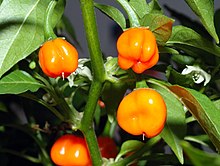Capsicum chinense
| Capsicum chinense | |
|---|---|
 |
|
| Habanero fruits | |
| Scientific classification | |
| Kingdom: | Plantae |
| (unranked): | Angiosperms |
| (unranked): | Eudicots |
| (unranked): | Asterids |
| Order: | Solanales |
| Family: | Solanaceae |
| Genus: | Capsicum |
| Species: | C. chinense |
| Binomial name | |
|
Capsicum chinense Jacq. |
|
| Synonyms | |
|
|
Capsicum chinense, commonly known as the "bonnet pepper", is a species of chili pepper native to the Americas. C. chinense varieties are well known for their exceptional heat and unique flavors. The hottest peppers in the world are members of this species, with Scoville Heat Unit scores of over 1.5 million. Some taxonomists consider them to be part of the species C. annuum, and they are a member of the C. annuum complex.C. annuum and C. chinense pepper plants can generally be identified by the number of flowers or fruit per node, however—one for C. annuum and two to five for C. chinense, though this method is not always correct. The two species can also hybridize and generate inter-specific hybrids.
Despite its name, C. chinense or "Chinese capsicum" is misleading. All Capsicum species originated in the New World.Nikolaus Joseph von Jacquin (1727–1817), a Dutch botanist, erroneously named the species in 1776, because he believed they originated in China due to their prevalence in Chinese cuisine after their introduction by European explorers.
Within C. chinense, the appearance and characteristics of the plants can vary greatly. Varieties such as the well-known Habanero grow to form small, compact perennial bushes about 0.5 metres (1 ft 8 in) in height. The flowers, as with most Capsicum species, are small and white with five petals. When it forms, the fruit varies greatly in color and shape, with red, orange, and yellow being the most common mature colors, but colors such as brown and purple are also known. Another similarity with other species would be shallow roots, which are very common.
C. chinense is native to Central America, the Yucatan region, and the Caribbean islands. The term Habanero, meaning from Habana (Havana, Cuba), comes from the fact that several peppers of this species were exported out from this port in its native range.
...
Wikipedia
